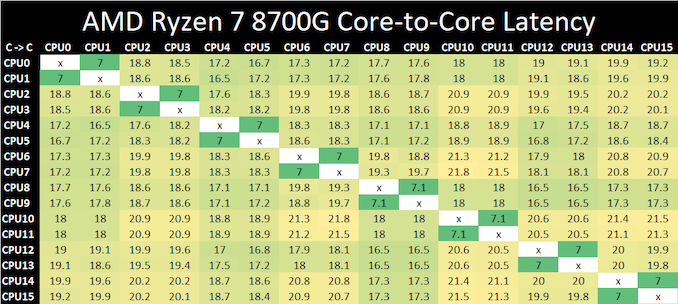AMD Ryzen 7 8700G and Ryzen 5 8600G Review: Zen 4 APUs with RDNA3 Graphics
by Gavin Bonshor on January 29, 2024 9:00 AM EST- Posted in
- CPUs
- AMD
- APUs
- Phoenix
- 4nm
- Zen 4
- RDNA3
- AM5
- Ryzen 8000G
- Ryzen 7 8700G
- Ryzen 5 8600G
Core-to-Core Latency
As the core count of modern CPUs is growing, we are reaching a time when the time to access each core from a different core is no longer a constant. Even before the advent of heterogeneous SoC designs, processors built on large rings or meshes can have different latencies to access the nearest core compared to the furthest core. This rings true especially in multi-socket server environments.
But modern CPUs, even desktop and consumer CPUs, can have variable access latency to get to another core. For example, in the first generation Threadripper CPUs, we had four chips on the package, each with 8 threads, and each with a different core-to-core latency depending on if it was on-die or off-die. This gets more complex with products like Lakefield, which has two different communication buses depending on which core is talking to which.
If you are a regular reader of AnandTech’s CPU reviews, you will recognize our Core-to-Core latency test. It’s a great way to show exactly how groups of cores are laid out on the silicon. This is a custom in-house test, and we know there are competing tests out there, but we feel ours is the most accurate to how quick an access between two cores can happen.
Looking at core-to-core latencies of the AMD Ryzen 7 8700G, as this is a monolithic Phoenix die, we can see good inter-core latencies between each of the eight individual Zen 4 cores. Going within the core, we can see solid latencies of 7ns, while things inter-core range between 17 and 21ns, showing that the Ryzen 7 8700G uses a single core cluster of eight cores.
Similar to what we've seen on previous iterations of Zen 4 and Zen 3, albeit on processors with multiple core complex (CCXs) such as the Ryzen 9 7950 and Ryzen 9 5950X, inter-core latencies are strong and low. In contrast, the Ryzen 7 8700G and other Ryzen 8000G monolithic chips on a single die remove the complications and penalties of connecting through AMD's Infinity Fabric interconnect. The Ryzen 7 8700G uses TSMC's refined 4nm manufacturing process, exactly the same as the Ryzen 7040 mobile, which is coincidentally the exact same design as the 8700G, given that AMD has repurposed Phoenix for use on AMD's AM5 desktop platform.
The core-to-core latency performance is inherently strong on the Ryzen 7 8700G, with low inter-core latencies. As expected, latency degrades a little going across the entire complex, but certainly not within the range where we would expect these penalties to cause latency issues when cores have to communicate with each other.











111 Comments
View All Comments
James5mith - Monday, January 29, 2024 - link
"These limitations primarily come in highly intensive multi-threaded workloads such as rendering or encoding, where the performance of processors such as the Ryzen 7000 desktop series, but the key point is that these APUs aren't inherently designed for these tasks in mind, and users looking for more CPU grunt are almost certainly likely to opt for a higher grade processor with faster cores, more cores, and more threads. "That is a) a massive run-on sentence, and b) doesn't make much actual sense. For example:
"where the performance of processors such as the Ryzen 7000 desktop series"
Where the performance does what? Or is what? There is no coherent thought in that comma delimited side note.
GeoffreyA - Tuesday, January 30, 2024 - link
The performance of the 7000 series excels at multithreading.yankeeDDL - Monday, January 29, 2024 - link
I wish there were some more remarks vs Intel's offering.CPU-wise Ryzen is more efficient, generally speaking. The performance seems same or slightly lower when compared with CPU that burn 400W to reach crazy boost rate. Still, that's my view.
Comparing it only against Ryzen 5*** seems a bit limited, no?
meacupla - Monday, January 29, 2024 - link
Ryzen 5000G is the primary competitor for Ryzen 8000G.It's next closest competition comes from the mobile segment in the form of mini-PCs.
Intel hasn't offered an APU for its desktop socket in ages.
yankeeDDL - Thursday, February 1, 2024 - link
Not correct.Ryzen 8000G is the only Zen4 desktop CPU on TSMC 4nm process (Ryzen 7000 is also Zen4, but on 5nm).
So - iGPU aside - I expect the 8000G to be more efficient than the 7000. Hence, I am curious as to how it would perform against Intel and also against the 7000.
Grapple - Monday, January 29, 2024 - link
Comparing against Intel’s 65W T-series processors would have made this article much more interesting.FWhitTrampoline - Monday, January 29, 2024 - link
T series is 35W and mostly for thin client Mini Desktop Business PCs but at least the T series are Socket Packaged! And Intel Made a Big mistake not releasing at least a 65W Socket Packaged Meteor Lake SKU. And Intel is very well capable of offering a socket packaged Mobile Processor because I'm still using my HP ProBook 4540s laptop with a Socket Packaged Ivy Bridge generation 3632QM processor and that laptop can get a processor update of MB replacement and reuse the same processor!meacupla - Monday, January 29, 2024 - link
I disagree. But only on processor choice.Ryzen 7840HS, Intel i7-13700H and i7-1370P would be my choice.
TheinsanegamerN - Tuesday, January 30, 2024 - link
Given that this is a desktop chip, it'd make more sense to compare it to other desktop chips.Otherwise, throw an M3 and a nvidia t100 car processor while youre at it.
meacupla - Tuesday, January 30, 2024 - link
Hahaha, nope.8000G are mobile chips using a desktop socket.